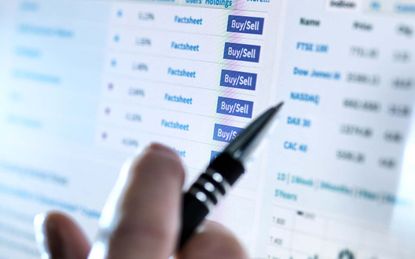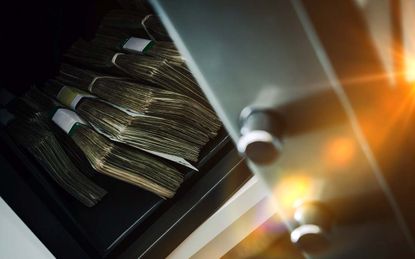How to Invest in This Bear Market


Now that we're officially well into bear-market territory now, the question is: How do you invest in the midst of one?
The Dow Jones Industrial Average dropped into bear territory on Wednesday, March 11. The S&P 500 and Nasdaq followed suit the following day, as Thursday, March 12, saw the biggest drop in the stock market since the 1987 market crash. For those not versed in market lingo, a bear market is a decline of 20% or more in stocks. This is more severe than a stock market correction, which is a decline of 10% to just under 20%.
These numbers are arbitrary, of course. As an investor, you don't necessarily care if your portfolio drops by exactly 20% or if it loses just 19%. But semantics aside, the bear market is here and growling with a vengeance.
It's been a while since we've had a proper bear market – the last one was during the 2008 financial crisis. For a few, it's entirely possible that this is the first one you've had to live through as an investor.
But even if you're a grizzled market veteran, this bear market – which is being fueled by a global pandemic, in the form of the COVID-19 coronavirus outbreak – has been full of surprises. It's the fastest bear market in history as measured by the length of time it took stocks to fall from new all-time highs to official bear territory. It took the Dow Industrials just 20 days to drop into bear territory, and the S&P 500 and Nasdaq just 21.
Today, we're going to cover the basics of how to invest in bear markets and make a portfolio action plan. The coming weeks might be rough, but we'll get through this together.

Bear Markets: A Quick History
The stock market is centuries old and steeped in lore. No one really knows where its vocabulary comes from. It's thought that the expression "bear market" comes from the way a bear's claws strike downward, just as the term "bull market" comes from the upward motion of a bull thrusting its horns.
But the truth is that the expressions have been around for so long no one really knows who thought them up or what exactly the origins were.
The current bear market is young, and we don't yet know how long it will last or how deep the losses will be. Given its record speed thus far, it wouldn't be surprising if the recovery were equally fast. But it's also entirely possible that the psychological trauma will cause it to be much worse. At this stage, there's no real way to know. But we can use history, and numbers, as a guide.
According to data compiled by Dow Jones, the median number of days between the S&P 500 hitting its peak and hitting its eventual low was 187 days. And the median time from entering a bear market to hitting its eventual low was 71 days. The median loss in each bear market was 32.9%.
Those are just medians, of course. Some bear markets are quicker, some drag out much longer. Some barely qualify as bear markets, falling just more than 20%, while others drop much farther. For example, the bear market triggered by the 2008 financial crisis saw the S&P 500 lose 51.9% of its value, and the 1973-74 bear market wasn't far behind it, shedding 48.2%. But the bear markets of the 1950s and 1960s saw declines of just 21.6% and 22.5%, respectively.
At the rate things are moving, these words will be out of date by the time they are printed, but as I write, the current bear market has the S&P 500 down about 26%, or about 7 percentage points above the median decline.
There's no good historical precedent here. The current coronavirus scare has been likened to the Spanish flu of 1918, though it's hard to consider that a good comparison given that World War I was ramping up. But for what it is worth, the Dow Industrials only dropped about 11% during the worst of the flu scare.
Now, we're ready to talk about what to expect, and how to invest in this bear market.

Expect Volatility
We've seen a lot of records broken in this bear market. The four largest down days in terms of daily point losses on the S&P 500 have all happened since Feb. 27.
Yet interestingly, the four largest up days have all happened during the same period, too.
Looking at percentages gives us slightly different numbers. There were numerous days during the pits of the 1930s Great Depression that saw bigger daily moves, both up and down, and there was the 1987 market crash that saw the S&P 500 drop more than 20%.
But there is a theme here. Volatility spikes during a bear market, whipsawing stocks both up and down. On Thursday, March 12, the S&P 500 sustained its worst drop since 1987, only to be followed by one of the greatest one-day jumps in history just a day later. Under normal circumstances, that's extremely unusual. Under these circumstances, you should expect more of the same. Of the top 10 biggest daily gains in index history, literally all took place during bear markets.
But why?
It's easy to understand why the biggest down days happen during bear markets. Investors panic and rush to sell, and buyers disappear. The market gets illiquid, and prices drop like a rock.
But similar dynamics play out on the upside. Short sellers have to eventually close out their short positions, which means they have to buy. And as liquidity tends to dry up, this buying can cause the market to jump in a hurry. Plus, investors who fear they missed the bottom often pile on.
The practical takeaway: Don't be suckered in by every move. A huge one-day burst doesn't necessarily mean the bottom is in. The rule of the day is volatility. You should simply expect the swings to be bigger both ways.

Rebalance
Ideally, you were allocated well going into this bear market. If you had your portfolio diversified across stocks, bonds, real estate and other asset classes, you likely have nothing to worry about as far as your portfolio's balance is concerned.
Unfortunately, after a long, 11-year bull market, many investors were over-allocated to stocks and now have some difficult decisions to make.
We'll go through some scenarios, but first, a little perspective. If you were invested mostly in index mutual funds or ETFs, your losses haven't been catastrophic just yet. Yes, a 25% loss is painful and scary. But this takes the S&P 500 back to roughly December 2018 levels. This bear market essentially eliminated the speculative froth that had built up over the past year.
Now, for a game plan.
The first thing you should do is rebalance your portfolio. That could mean getting more defensive or getting more aggressive, depending on how you're currently invested. But the first step is to figure out what your allocation to stocks should look like.
As a very general rule of thumb, the typical investor should have something in the ballpark of 100 to 120 minus their age in stocks. So, if you're 60 years old, having 40% to 60% in stocks is about right. If you have more than that, you should probably lighten up. If you have less, you could use this bear-market discount as an opportunity to buy the dip.
We don't know what happens next, but being systematic like this helps us to keep a level head and let the long-term averages work in our favor.

Make Your List
Now, for the fun part. During bear markets, you get a chance to buy stocks you've always wanted at prices you never thought possible.
So, make a list of stocks you've always wanted to buy and look at their prices. Are they attractive? Is this a price you would have loved to see two months ago, before the world started to end?
If so, then take your chances. If you're nervous, you can always break up your purchase into smaller blocks and average in over the course of a few weeks.
The legendary Sir John Templeton made a fortune doing exactly what we've described here. Templeton was known to keep standing limit orders in place for stocks he liked but not necessarily at the prevailing market prices. He knew that if the market really hit a rough patch, he might lose his nerve and miss the opportunity. Keeping the limit orders in place made it automatic. If his price got hit, he bought the stock. If it didn't … he didn't.
Templeton wasn't any different than the rest of us. He would get jittery when he saw extreme volatility. But that's exactly why he took his emotions out of the equation by making the purchase decision cold, rational and automatic.

Hoard Cash
Of course, it's only possible to make moves like Templeton's if you have the cash on hand to do it. As a general rule, you should always keep a little cash on hand. But in a bear market, it becomes all the more important.
Let's say you have bonds or CDs maturing soon or even large dividend payments. Or let's say you had stops in place that got triggered, or you plan on selling out some weak positions. All of this represents firepower that you can eventually put to work.
The key is to be patient and wait for your moment. Don't be in a hurry to buy on the way down. Wait for your moment and only then pounce. And if you miss it, don't fret. It's possible you didn't actually miss it. You still might get another chance if the market takes yet another leg down.
And if the stocks you like never quite hit your buying range, so be it. There will be other opportunities elsewhere.
We might not know for a while just how bad this ends up being. The economy has already sustained damage that we won't see reported in the numbers for another several months. But it's important to remember that this too will pass. For now, protect yourself as best you can, and that means your portfolio too.
Hang in there. It might get worse from here, and it certainly will be volatile. But it will get better.
Get Kiplinger Today newsletter — free
Profit and prosper with the best of Kiplinger's advice on investing, taxes, retirement, personal finance and much more. Delivered daily. Enter your email in the box and click Sign Me Up.

Charles Lewis Sizemore, CFA is the Chief Investment Officer of Sizemore Capital Management LLC, a registered investment advisor based in Dallas, Texas, where he specializes in dividend-focused portfolios and in building alternative allocations with minimal correlation to the stock market.
